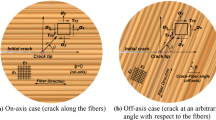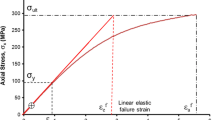Summary
A simple model, based on the use of transformations of second-order tensors, is presented in this paper to predict the failure mode of wood members stressed in various degrees of parallel-and perpendicular-to-grain tension and parallel-to-grain shear. This type of loading is indicative of structural wood members with cross grain or grain deviations in the vicinity of knots subjected to bending or tension. The model is based on the assumptions that failure is dictated by the presence of any of the aforementioned stresses that exceed the clear wood strength in that mode and that failure does not result from stress interactions. The magnitudes of the applied stresses are normalized relative to the wood strength in that mode. The ratio of applied stress to material strength that is greatest at any particular angle of load to grain is presumed to be the failure mode at that angle. To verify model predictions, optical and microscopic analyses of surfaces of failed specimens loaded in uniaxial tension at angles between 0° and 90° to grain were compared to previously obtained, or otherwise known, surfaces of specimens tested in tension and shear. Specimens tested at various angles to grain demonstrated failed surfaces very much like those associated with specimens loaded in the modes predicted by the model.
Similar content being viewed by others
References
American Society for Testing and Materials. 1979. Standard Methods for Establishing Clear Wood Strength Values, D-2555. Philadelphia, PA.
Anthony, R. W.; Bodig, J.; Goodman, J. R.; Smith, F. W.; Pellicane, P. J. 1986: Experimental Data for the Tension Behavior of Douglas-fir with Defects. Structural Research Report No. 58, Dept. of Civil Engineering, Colorado State University, Ft. Collins, Colorado, U.S.A.
Barrett, J. D.; Foschi, R. O. 1977: Mode II Stress-intensity Factors for Cracked Wood Beams. Engineering Fracture Mechanics 9: 371–378
Boatwright, S. W. J.; Garrett, G. G. 1979: The Effect of Knots on the Fracture Strength of Wood II. A Comparative Study of the Methods of Assessment, and Comments on the Application of Fracture Mechanics of Structural Timber. Holzforschung 33: 73–77
Bodig, J. 1965: The effect of anatomy on the initial stress-strain relationship. Forest Prod. J. 15: 197–202
Boontanjai, C. 1979: The Fracture Toughness Properties of Pinus radiata. M. Eng. Thesis. University of Auckland, Auckland, NZ.
Boresi, A. P.; Sidebottom, O. M.; Seely, F. B.; Smith, J. O. 1978: Advanced Mechanics of Materials. John Wiley & Sons, New York
Clarke, S. H. 1935: Recent work on the relation between anatomical structure and mechanical strength in English ash. Forestry 9: 132
Côté, W. A.; Hanna, R. B. 1983: Ultrastructural Characteristics of Wood Fracture Surfaces. Wood and Fiber Science 15(2): 135–163
Hetényi, M. 1968: (Ed.) Handbook for Experimental Stress Analysis. Soderberg, C. R., “Working Stress,” Chapter 10. John Wiley & Sons, New York
Hu, L. W. 1958: Modified Tresca's Yield Condition and Associated Flow Rules for Anisotropic Materials and Application. Journal of the Franklin Institute
Kennedy, R. W.; Ifju, G. 1962: Applications of Microtensile testing of Thin Wood Sections. TAPPI 45(9): 725–733
Kloot, N. H. 1952: A micro-testing technique for wood. Australian Journal of Applied Science 3(2): 125–143
Ko, C. H. 1972: Failure Theories for Orthotropic Materials. M.S. Thesis. Colorado State University, Ft. Collins, Colorado, U.S.A.
Leicester, R. H. 1974: Fracture Strength of Wood. Paper presented at the First Australian Conference on Engineering Materials. The University of New South Wales, Melbourne, Australia
Marin, J. 1975: Theories of Strength for Combined Stresses and Nonisotropic Materials. Journal of the Aeronautical Sciences, April, 265–274
Mindess, S.; Nadeau, J.; Barrett, J. D. 1975: Slow Crack Growth in Douglas-fir. Wood Science 8(1): 389–396
Pearson, R. G. 1974: Application of Fracture Mechanics to the Study of the Tensile Strength of Structural Lumber. Holzforschung 28: 11–19
Pellicane, P. J. 1980: Ultimate Tensile Strength Analysis of Wood. Ph.D. Dissertation. Colorado State University. Ft. Collins
Pellicane, P. J.; Bodig, J.; Goodman, J. R. 1982: Simulation of the Tensile Strength-Fracture Toughness Relationship. Wood Science 14(4): 168–177
Porter, A. W. 1964: On the Mechanics of Fracture in Wood. Forest Prod. J. 14(8): 325–331
Robinson, W. 1920: The microscopical features of mechanical strains in timber and the bearing of these on the structure of the cell wall in plants. Philos. Trans. Soc. London. Series B 210: 49–82
Schniewind, A. P.; Lyon, D. E. 1973: A Fracture Mechanics Approach to the Tensile Strength Perpendicular to Grain of Dimension Lumber. Wood Sci. Technol. 7(1): 45–59
Schniewind, A. P.; Ohgama, T.; Aoki, T.; Yamada, T. 1982: Effect of Specific Gravity, Moisture Content, and Temperature on Fracture Toughness of Wood. Wood Science 15(2): 101–109
Smith, F. W.; Penney, D. T. 1980: Fracture Mechanics Analysis of Butt Joints in Laminated Wood Beams. Wood Science 12(4): 227–235
Triboulot, P.; Jodin, P.; Pluvinage, G. 1984. Validity of Fracture Mechanics Concepts Applied to Wood by Finite Element Calculations. Wood Sci. Technol. 18: 51–58
Valentin, G. H.; Boström, L.; Gustafsson, P. J.; Ranta-Maunus, A.; Gowda, S. 1991: Application of fracture mechanics to timber structures RILEM state-of-the-art report. Research Notes 1262, Technical Research Centre of Finland, Espoo, pp. 142
Waddoups, M. E. 1967: Advanced Composite Materials Mechanics for the Design and Stress Analysis. General Dynamics. Ft. Worth Division Report, Ft. Worth, Texas, U.S.A.
Wardrop, A. B.; Addo-Ashog, F. W. 1963: Fracture, in: Proceedings, First Tewksbury Symposium, University of Melbourne, pp 169–182
Wright, K.; Leppavouri, E. 1984: Application of Fracture Mechanics: Fracture Toughness of Finnish Wood. Technical Research Centre of Finland, Espoo, Finland
Zink, A. G. 1986: Ultrastructural Characteristics of Softwood Fracture Surfaces. M.S. thesis, Colo State Univ. Ft. Collins, Colorado, U.S.A.
Zink, A. G.; Pellicane, P. J.; Shuler, C. E. 1991: Ultrastructural Analysis of Softwood Fracture Surfaces. Wood Sci. Technol. 28: 329–338
Author information
Authors and Affiliations
Rights and permissions
About this article
Cite this article
Zink, A.G., Pellicane, P.J. & Anthony, R.W. A stress transformation approach to predicting the failure mode of wood. Wood Sci.Technol. 30, 21–30 (1995). https://doi.org/10.1007/BF00195265
Received:
Issue Date:
DOI: https://doi.org/10.1007/BF00195265




